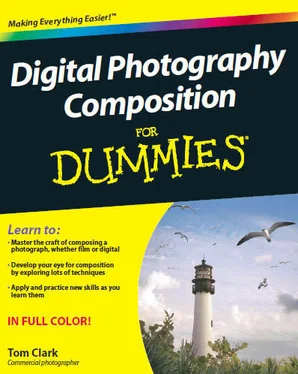Do an online search for American Gothic to see just how many photographers have emulated it. You'll see a large variety of conceptual twists that should jump-start your own creativity.
Films are a great source for inspiration with regard to photographic composition. In a quality film, the directors of photography and art make camera angles, lighting, color schemes, and lens choices based on the narrative qualities they're looking for.
When watching a movie, pay attention to the main subjects' relationships to the other elements in a frame and how those relationships affect your understanding of the scene. Notice the different types of lighting during different scenes, and determine which mood is associated with which lighting type. What scenes use soft light and which ones use hard light? Is there a high level of contrast? (Chapter 10 tells you more about lighting.)
Some movie moments are depicted with wide-angle lenses and others with telephoto lenses. (You find out about lens types in Chapter 3.) Take notes on how moviemakers use different lenses to convey different messages. With an understanding of how different compositional techniques are put to use, perhaps you can find some inspiration to put those techniques into practice with your own photography.
Museums hold inspiration in its purest form. Looking at the online images of the great works of art is convenient and useful, but it's nothing like seeing the real thing. Most of the artwork displayed in museums is chosen for a reason. In most cases, the art world has recognized these pieces as having artistic qualities that could be of value to the public. So take my word for it and head out to your local museum (or do some traveling to see a museum that's new to you).
If the museum you visit offers a tour, take it and see what the curator has to say about the pieces you see. Listen to what he says about balance and scale, color, and technique. Try to notice compositional qualities in three-dimensional works of art (sculptures, installations, and so on); this different medium could inspire you to try something new when photographing.
Similarly, if you have a favorite photographer — one who inspired you to pick up a camera in the first place — you should see that photographer's work in person. Doing so is far more satisfying than seeing it in books or on the Web, and it will inspire you to continue creating your own images. To find out where you can view a specific photographers work, do an online search of their name with keywords such as "gallery exhibition" or "news."
Compile a Wall of Inspiration
When flipping through magazines, you'll likely come across images that jump out at you. Perhaps it's the lighting, the successful use of perspective, or the combination and balance of colors that gets your attention. Regardless of what draws you in, clip the page from the magazine and pin it up in your office or studio so you can see it on a regular basis.
As you post these images on your wall, you collect concepts and techniques that you find attractive to inspire you. If you simply take mental notes when you're inspired by images, chances are you'll soon forget about them. If you pin up the images where you can see them, you'll have a constant reminder.
Maybe you feel like all your images are starting to look the same, or maybe you want to use certain techniques but can't achieve them with your current lenses. If that's the case, look into a new lens! In most cases, a new lens is even more valuable than a new camera body; the camera's digital sensor sees only what the lens reveals to it.
Getting a new lens for your digital SLR is similar to getting a new toy as a child. Because the lens is new and different, it's interesting. You'll automatically be inspired to go out photographing.
If you can't afford to buy a new lens or aren't sure which one to get, try your local rental house. At a rental house, for a small rental fee you can try out various lenses. Doing so helps you decide which one works best for you and which one provides the most inspiration to create new images. To locate your nearest rental house, try searching the local business listings online. Or you can always ask a friend who may be in the know.
Head Out for a Nighttime Photo Shoot
Most photographers shoot during the day. If you want to create images that stand out from the norm (and you want to have a good time doing it), try shooting at night with long exposures.
Shooting at night is the same as shooting during the day except that you have much less natural light to work with. As a result, your exposures are very long. (With this in mind, be sure to bring your tripod.) Most digital SLR cameras allow you to set your shutter speed at a maximum of 30 seconds.
In some cases, this is more than enough time. However, if you notice that a night scene is underexposed at 30 seconds and your aperture is wide open and your ISO is maxed out, your only option is to increase the time of your exposure. (Chapter 3 discusses how to manage your exposure value by setting your shutter speed, aperture, and ISO.)
The setting that allows you to open your shutter for custom, extended periods of time is known as bulb. (Refer to your owner's manual to find out how to set your camera to bulb.) After you've set your camera to this setting, you can hold down your shutter release button for the amount of time you would like to expose a scene. With this setting, you can expose an image for as long as your batteries will allow.
Holding your finger on the camera while it's exposing a scene for a lengthy period of time isn't practical. Doing so causes motion blur because the camera shakes — and it's not very fun, either. You have two options for solving this problem:
Buy a shutter release cable.This cable, which is perfect for long exposures, attaches to your camera and gives you control of the shutter without having to touch the camera. If you're going to buy a shutter release cable, be sure to research the different options available for your specific camera and read reviews written by other photographers on each product. Some shutter release cables offer various features, such as wireless capabilities and time-lapse options (as discussed in the later section "Reveal the Lapse of Time in a Scene"). Make sure you get one that has the features you want and is priced to fit your budget.
Use the tape and pebble system.This is my own method of choice. With my camera set to bulb, I set up my shot and then carefully attach the lens cap to keep light from getting in once my shutter is opened. I then place a pebble over the camera's shutter release button and tightly wrap gaffer's tape around it and the camera body. The tape holds the stone in place, and my shutter remains open. To begin my exposure, I gently but quickly remove the lens cap. To finish the exposure, I simply put the lens cap back on, and then I peel off the tape to free the pebble. This method clearly is the more economical one if you don't want to purchase a shutter release cable.
It's best to avoid using duct tape or any type of tape that gets its stick from a thick adhesive. Gaffer's tape is commonly used by photographers because it doesn't leave a sticky residue after it's peeled off a surface.
Having the ability to control your shutter speed beyond 30 seconds is important for when you want to shoot at smaller apertures for more depth of field and lower ISO ratings, which I tell you about in Chapter 7.
Reveal the Lapse of Time in a Scene
One inspiring way to reveal a scene by using your camera is to create a time lapse. A time lapse is a sequence of images taken over a period of time. These images reveal the changes that occurred during that time in the scene. With the camera positioned on a tripod (for maximum stability), you can arrange to have an image taken once every minute or so. Changing the frequency of how often an image is taken changes the effect of your final results. Shorter durations between shots provide more gradual changes in the scene, and longer durations between shots provide more abrupt changes in the scene.
Читать дальше
Конец ознакомительного отрывка
Купить книгу












